What Is Chronic Venous Insufficiency?
What exactly is venous insufficiency?
Venous insufficiency is a condition associated with the arteries in your body that carries blood from your heart to the other parts of the body. The veins carry and pull blood to the heart, and the valves in the veins prevent the blood from flowing back.
When the veins get damaged, they cannot send blood to your other body parts. This part is called venous insufficiency.
During this diagnosis, the blood is unable to carry back to the heart, which causes a pool of blood to clot in the veins of your legs.
Various reasons could be behind the cause of this condition, but it’s mostly caused by the blood’s clots, also known as Deep Vein Thrombosis. If there’s a family hierarchy of venous insufficiency cases, you can follow the below-mentioned necessary steps to avoid this condition.
What causes venous insufficiency?
This condition of venous insufficiency is mostly caused by the clots of blood or varicose veins. When the veins are healthy, there’s a consistent passage of blood from the limbs of the body back towards the heart.
The valves that exist inside the veins of the legs help avoid the flow of blood backward. The most commonly found reason for venous insufficiency is the cases of blood clots and varicose veins. When the blood moves forward, and if there’s an obstruction, the blood starts to collect below the blood clot, leading to the condition of venous insufficiency.
In varicose veins, the valves within the veins get damaged, which allows the blood to flow through the impaired valves. In a few cases, soreness or weakness in the legs that ooze out blood can also contribute to venous insufficiency.
This condition is more commonly found in women rather than in men. According to a clinic, this condition is more likely to occur in adults whose age exceeds 50.
Risks of venous insufficiency:
There are various risks involving venous insufficiency that could cause this condition. It includes clots in the blood, varicose veins, smoking, cancer, obesity, overweight. Weakness in muscles, soreness, family hierarchy history of the same condition, standing or sitting motionless for longer durations.
What are the symptoms of venous insufficiency?
Many symptoms may cause venous insufficiency:
- Swelling of legs and ankles.
- Cramps in the leg.
- The heaviness of the legs.
How can venous insufficiency be diagnosed?
You can get yourself diagnosed by taking a physical examination done by a practitioner. It also involves examining and analyzing a person’s medical history to understand if you have this condition. The tests may also have some imaging to be done to identify the primary source of the issue. The imaging tests may include either a duplex ultrasound or even a venogram.
What happens in a venogram?
When a venogram is conducted, the doctor will use an IV contrast dye to your veins. This dye allows the blood vessels to look non-transparent on an X-ray, thereby completely getting insight into your affected vein. They provide a complete portrayal of your blood vessels, which is required to diagnose the condition of venous insufficiency.
What happens in a Duplex Ultrasound?
This type is used to understand the speed, force, and direction of the blood flow in your veins. A technical assistant will put some gel on your skin and then use a transducer device in this area. This device uses the sound wave technology that reflects on a computer that allows them to capture blood flow images.
How can venous insufficiency be treated?
The kind of treatment implemented for this condition will depend on a combination of factors. Some of them include looking for key symptoms, sex, age, the seriousness of the condition, tolerance towards accepting medicines, and surgical procedures.
One of the most commonly used treatments for venous insufficiency is compression stockings. These flexible and elastic stocking put direct pressure on the ankle and allow healthy blood flow to reduce swelling in the legs. The compression stockings have a variety of prescriptions and various lengths. Your doctor will understand and prescribe the perfect kind of compression stocking that may help you in your treatment.
What kind of tips can be used for this condition?
Get your blood flow improving:
One of the constant things you can do for this condition if its mild would be to improve the blood flow. Follow some of the steps given below:
Elevation of your legs:
Keeping your legs elevated when you sit or stand without movement will help blood flow to your heart and body. It also allows your veins not to get damaged as the valves pump blood continuously.
Use compression stockings:
The usage of compression stockings will allow the blood to be squeezed through your legs. It keeps your veins intact and doesn’t allow any damage.
Uncross your legs while sitting:
When you sit with crossed legs, you’re allowing the blood to not pass through your heart and body. Uncrossing your legs will allow a healthy flow of blood.
Constant exercise:
Remaining fit and conducting regular exercises is a great way to avoid getting this condition. Apart from this condition, it also allows you to keep away from any cardiovascular diseases that may happen due to non-activities.
Sclerotherapy:
This is a very common method that’s adopted to treat serious conditions of venous insufficiency. In Sclerotherapy treatment, there’s a chemical that’s directly injected into a damaged vein to carry blood for a longer duration.
The blood will pass through to the heart through other veins, and the affected vein finally is consumed by the body. The sclerotherapy treatment is more commonly used to get rid of either small or medium veins. It may not be used to treat large-sized veins.
A catheter usage:
In extremely severe cases, a doctor might use a catheter for the large-sized veins. The medical staff will insert a catheter, which is a thin tube directly into the vein, and through the heat, the damaged veins get sealed, and as soon as its done, the catheter is taken off.
How can you prevent this condition?
In case this condition runs through your family, you can follow the below steps to reduce the possibilities of getting this condition:
- Avoid sitting or standing in a similar position for longer durations. Keep moving around constantly to keep your blood flowing.
- If you’re a smoker, now’s the time to quit smoking, which is known to be a reason for causing this condition.
- Get yourself constant exercises and keep your physical and mental well-being well.
Bottom line:
Even though chronic venous insufficiency may not be an extremely severe case, it does cause discomfort and can be a long-term ailment if not treated accurately. One of the best aspects of undergoing cardio exercises is that it allows you to keep a healthy heart. In case you want to know some more information on this, you can get an appointment here to know more.




